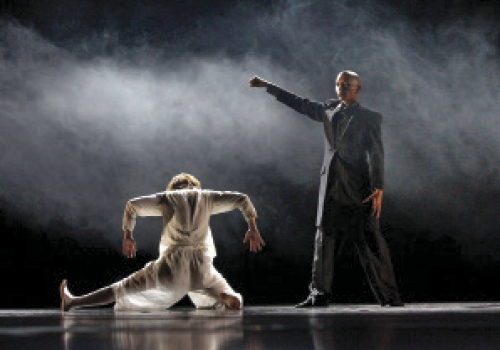The Grand Prix at the International Festival of Modern Choreography in Vitebsk (IFMC-2014) was taken by Ayaka Habata and Cotaro Ito from Tokyo. Their work was called Nil — emptiness, nothing, zero. It appears to be nothing of the sort however, as their dance combines emotion and drama to make an almost musical performance.

Dance Company Ayaka Habata & Cotara Ito from Japan perform. BELTA
The outcomes of such competitions as these are often controversial, the public and the judges commonly disagree. On IFMC-2014 there was no discrepancy between the two — the Japanese showed us a true masterpiece, said the Chairman of the jury, the Art Director of the Kiev Modern Ballet, Radu Poklitaru. He explained, “The Grand Prix is always given to unique pieces, for art in its highest form. The work of the Japanese group combines dramatic art, faultless emotion and an extremely high technical level of performance.”
The first award was taken by Ilya Oshi from Vologda, whose dance On Finger-Tips, about the vulnerability of the human soul, surprised and delighted the choreographers amongst the jury. The panel members are all working actors and directors who have come to the festival from all over the world and from every sphere of dance. According to Yuri Troyan, Art Director of the National Academic Bolshoi Opera and Ballet Theatre of Belarus, original art is notable for its ability to reach out and touch people from all walks of life.
Members of the advisory panel recognised Olga Gorobchuk from the Omsk Theatre of Dance as the best choreographer of the competition with her piece nOga. The staging of the dance brought her a special award presented by Yevgeny Panfilov.
The competition saw more worthy works than there were prizes; consequently, the second and third places were sub-divided into six parts. The choreographers of the Theatre-Studio of Modern Choreography from Moscow took two third place prizes, Yegor Maslov for his short piece To Home and Pavel Glukhov for his one-act ballet Three Sisters. Directors from Kiev received the second prize (Specimen, Yaroslav Kainar) and the third (Reunification, Vladimir Mitev).
Our own country was well represented. Seven Belarusian groups reached the final, Diana Yurchenko from Vitebsk and Sergey Poyarkov from Minsk took the second prize in their category. A special award by the jury for the most talented debut act went to Valentin Isakov from Gomel for his work Spectrum, exploring teenage problems. While Olga Skvortsova, Art Director of Minsk SKVO’s Dance Company, received the award for the development of Belarusian contemporary dance.
The public often have difficulty understanding what a choreographer is trying to express in a dance, but according to the Art Director of the Chelyabinsk Theatre of Modern Dance, Olga Pona, this is the essence of contemporary performance. “Dance should be felt in your heart and bones, but not necessarily in your head. It gets inside you or it does not. Either you are involved in the process, or excluded. If you don’t understand the story of the dance, you can imagine your own interpretation, interact with the piece. This is what modern art is all about. Those who want a cut and dried narrative are welcome to watch drama, ballet and opera,” she said.
According to Swedish choreographer Örjan Andersson, the main purpose of modern dance is to surprise the audience. Both the organisers and participants of the Vitebsk dance festival have managed to do it for almost 30 years. This probably has a lot to do with Vitebsk being the birthplace of avant-garde.











